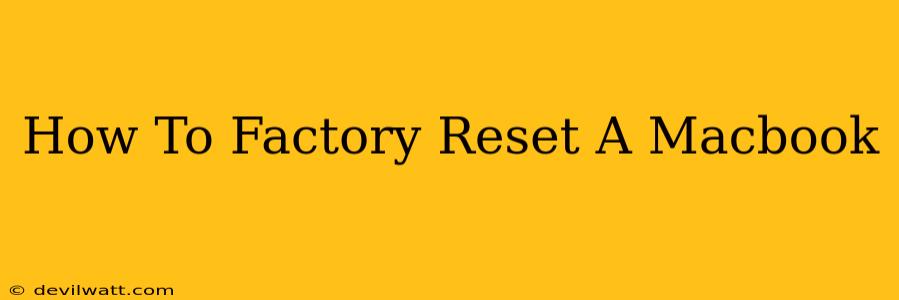Facing issues with your MacBook? A factory reset, also known as erasing your Mac, can often solve problems and get your system running smoothly again. This comprehensive guide walks you through the process, covering different scenarios and ensuring you're prepared for a clean slate.
Understanding Factory Resets on MacBooks
Before diving in, it's crucial to understand what a factory reset entails. This process completely wipes your MacBook's hard drive, removing all data, applications, and settings. Think of it as returning your MacBook to its original state, as if it just came out of the box. This action is irreversible, so backing up your important data is absolutely essential before proceeding.
When to Factory Reset Your MacBook
There are several reasons why you might need to factory reset your MacBook:
- Selling or giving away your MacBook: This ensures your personal information is completely removed.
- Troubleshooting software problems: A reset can fix various glitches, bugs, and performance issues.
- Preparing for a macOS reinstall: A clean install of macOS often requires a factory reset beforehand.
- Severe malware infection: If your Mac is infected with persistent malware, a factory reset might be the only solution.
Backing Up Your Data: A Crucial First Step
Before you begin the factory reset process, back up all your crucial data. This includes documents, photos, videos, music, and any other files you want to keep. There are several ways to do this:
- Time Machine: Apple's built-in backup solution is ideal for regular backups.
- External hard drive: Manually copy your files to an external hard drive.
- Cloud storage services: Services like iCloud, Google Drive, or Dropbox offer cloud-based backups.
Warning: Failing to back up your data could result in permanent data loss. This step is non-negotiable.
How to Factory Reset Your MacBook (Erase All Data)
There are two primary methods for factory resetting your MacBook, depending on whether your Mac is still operational:
Method 1: Erasing Your Mac While it's Still Bootable
- Shut down your MacBook.
- Open System Preferences.
- Click on "Apple menu" (top left corner) and select "System Settings."
- Select "General."
- Click "Transfer or Reset Mac."
- Choose "Erase All Content and Settings."
- Follow the on-screen instructions. You'll be prompted to enter your password and confirm the action.
This method is straightforward if your Mac is functioning normally.
Method 2: Erasing Your Mac From macOS Recovery
If your MacBook is experiencing significant issues and won't boot normally, you can use macOS Recovery:
- Shut down your MacBook.
- Turn on your MacBook and immediately press and hold the power button.
- Keep holding until you see the startup options window.
- Select "Options."
- Click "Continue." You might need to log in.
- Select "Disk Utility."
- Select your startup disk. This is usually named "Macintosh HD" or similar.
- Click "Erase." Choose a format (APFS is recommended) and name your drive.
- Click "Erase." This process will take some time.
- Quit Disk Utility.
- Restart your MacBook.
After the Factory Reset
Once the factory reset is complete, your MacBook will restart to the setup assistant. You'll be guided through the process of setting up your Mac with your preferred language, region, and other settings. This is your opportunity to set up your Mac as a brand new device, installing only the applications and software you need.
Troubleshooting
If you encounter issues during the reset process, consult Apple's official support website or contact Apple Support directly for assistance.
This comprehensive guide should help you successfully factory reset your MacBook. Remember, data backup is paramount, so always prioritize this step before proceeding. Good luck!

